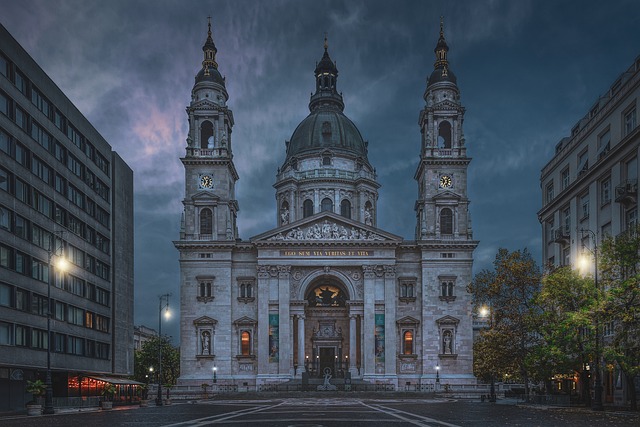A basilica in the Catholic Church is a type of church building that has been granted special ceremonial rights by the Pope. It is typically larger and more ornate than a regular parish church and may have historical or architectural significance. Basilicas are often used for important religious ceremonies and events.
Table of Contents
History of Basilicas in the Catholic Church
Basilicas hold a special place in the Catholic Church, serving as important religious and architectural symbols. But what exactly is a basilica, and why are they significant in the Catholic faith? Let’s delve into the history of basilicas in the Catholic Church to gain a better understanding of their importance.
The term “basilica” originates from ancient Rome, where it referred to a large public building used for various purposes, such as courts of law, markets, and meeting places. Over time, the Christian Church adopted the term to describe a specific type of church building that held particular significance. Basilicas were often built over the tombs of martyrs or as centers of pilgrimage, making them important sites for worship and devotion.
One of the earliest basilicas in the Catholic Church is the Basilica of St. John Lateran in Rome, which was consecrated in the 4th century. This basilica holds the title of “mother church” of the Catholic Church and is considered the highest-ranking of all Catholic churches. It serves as the cathedral of the Bishop of Rome, who is also known as the Pope.
As Christianity spread throughout Europe, basilicas became more common and took on various architectural styles. Some basilicas were built in the shape of a Latin cross, while others featured a central dome or nave. Regardless of their design, basilicas were intended to be grand and awe-inspiring structures that reflected the glory of God.
In addition to their architectural significance, basilicas also hold special ceremonial importance in the Catholic Church. A basilica is granted the title of “minor basilica” by the Pope, signifying its importance as a place of worship and pilgrimage. Minor basilicas are typically located in cities or towns with historical or religious significance and are often visited by pilgrims seeking spiritual enrichment.
Major basilicas, on the other hand, are the highest-ranking basilicas in the Catholic Church and are located in Rome. These basilicas hold particular importance as sites of papal ceremonies and are considered the most sacred places of worship in the Catholic faith. The four major basilicas in Rome are St. Peter’s Basilica, St. John Lateran, St. Mary Major, and St. Paul Outside the Walls.
Throughout history, basilicas have played a crucial role in the development of the Catholic Church and have served as centers of worship, pilgrimage, and devotion. They continue to be important symbols of the Catholic faith, drawing believers from around the world to experience their beauty and spiritual significance.
In conclusion, basilicas are more than just buildings; they are sacred spaces that hold deep religious and historical significance in the Catholic Church. From their origins in ancient Rome to their continued importance in the modern world, basilicas serve as reminders of the enduring power of faith and the beauty of worship. Whether visiting a minor basilica in a local community or making a pilgrimage to a major basilica in Rome, believers can find inspiration and solace in these magnificent structures that stand as testaments to the glory of God.
Different Types of Basilicas
Have you ever heard the term “basilica” in relation to the Catholic Church and wondered what it means? In the Catholic Church, a basilica is a special type of church that holds particular significance. There are different types of basilicas, each with its own unique characteristics and history. Let’s explore the different types of basilicas and what makes them special.
One of the most well-known types of basilicas is the Papal Basilica. These basilicas are designated by the Pope and are typically located in Rome. They hold special importance as they are considered to be the highest ranking churches in the Catholic Church. Some examples of Papal Basilicas include St. Peter’s Basilica and St. John Lateran. These basilicas are often visited by pilgrims from around the world and hold a special place in the hearts of Catholics.
Another type of basilica is the Patriarchal Basilica. These basilicas are designated by a patriarch, who is a bishop with jurisdiction over a particular area. Patriarchal Basilicas are typically located in major cities and serve as important centers of worship for the local community. Examples of Patriarchal Basilicas include the Basilica of St. Mary Major in Rome and the Basilica of St. Paul Outside the Walls.
There are also Minor Basilicas, which are designated by the Pope for their historical or architectural significance. These basilicas may not have the same level of importance as Papal or Patriarchal Basilicas, but they still hold a special place within the Catholic Church. Minor Basilicas can be found all over the world and are often visited by tourists and pilgrims. Some examples of Minor Basilicas include the Basilica of Our Lady of Guadalupe in Mexico City and the Basilica of the National Shrine of the Immaculate Conception in Washington, D.C.
Each type of basilica has its own unique characteristics and history, but they all share a common purpose – to serve as places of worship and pilgrimage for Catholics. Whether you are visiting a Papal Basilica in Rome or a Minor Basilica in your own hometown, you are sure to be struck by the beauty and significance of these special churches.
In conclusion, basilicas play an important role in the Catholic Church and hold a special place in the hearts of Catholics around the world. Whether you are visiting a Papal, Patriarchal, or Minor Basilica, you are sure to be inspired by the history and beauty of these special churches. Next time you hear the term “basilica” in relation to the Catholic Church, you will have a better understanding of what it means and why these churches are so important.
Significance of Basilicas in Catholicism

Have you ever heard the term “basilica” in relation to the Catholic Church and wondered what it means? Basilicas hold a special significance in Catholicism, serving as important places of worship and pilgrimage for believers around the world. In this article, we will explore the history and significance of basilicas in the Catholic Church.
The term “basilica” comes from the Greek word “basilike,” which means royal or kingly. In ancient Rome, basilicas were public buildings used for various purposes, such as courts of law, meeting places, and market halls. Over time, the Christian Church adopted the architectural style of basilicas for their places of worship, with some modifications to suit their religious practices.
Basilicas in the Catholic Church are typically large, grand churches that hold special significance for the faithful. They are often built in a cruciform shape, with a long nave leading to a raised platform or apse where the altar is located. Basilicas are usually adorned with beautiful artwork, statues, and stained glass windows that depict scenes from the Bible and the lives of saints.
One of the most well-known basilicas in the Catholic Church is St. Peter’s Basilica in Vatican City, which is considered the mother church of all Catholic churches around the world. St. Peter’s Basilica is built on the site where St. Peter, one of Jesus’ apostles, was believed to have been buried. It is a place of pilgrimage for millions of Catholics who come to pay their respects to the first pope and to experience the beauty and grandeur of the church.
Basilicas are also important for their role in hosting major religious ceremonies and events. Many basilicas are designated as “papal basilicas,” meaning they are under the direct authority of the Pope. These basilicas often host papal Masses, liturgical celebrations, and other important events in the life of the Church. The four major papal basilicas in Rome are St. Peter’s Basilica, St. John Lateran, St. Mary Major, and St. Paul Outside the Walls.
In addition to their religious significance, basilicas also serve as important cultural and historical landmarks. Many basilicas are renowned for their architectural beauty and artistic treasures, such as Michelangelo’s famous Pieta sculpture in St. Peter’s Basilica. Visitors from around the world come to admire the art and architecture of basilicas and to learn about the history of the Catholic Church.
Overall, basilicas play a vital role in the life of the Catholic Church, serving as places of worship, pilgrimage, and cultural heritage. They are symbols of the faith and devotion of millions of Catholics worldwide, and they continue to inspire awe and reverence in all who visit them. Whether you are a devout Catholic or simply a curious traveler, a visit to a basilica is sure to leave a lasting impression on your heart and soul.
Famous Basilicas Around the World
Basilicas are an important part of the Catholic Church, serving as places of worship, pilgrimage, and historical significance. These grand buildings are often characterized by their large size, ornate decorations, and historical importance. They are typically designated by the Pope as a special place of worship, and many of them hold relics or important religious artifacts.
One of the most famous basilicas in the world is St. Peter’s Basilica in Vatican City. This massive church is the largest in the world and is considered one of the holiest sites in Christianity. It is built on the site where St. Peter, one of Jesus’ apostles, is believed to be buried. The basilica is known for its stunning architecture, including the famous dome designed by Michelangelo.
Another famous basilica is the Basilica of Our Lady of Guadalupe in Mexico City. This basilica is dedicated to the Virgin Mary and is one of the most visited Catholic pilgrimage sites in the world. It is built on the site where the Virgin Mary is said to have appeared to a Mexican peasant, Juan Diego, in 1531. The basilica houses the famous image of Our Lady of Guadalupe, which is believed to be miraculous.
In Italy, the Basilica of St. Francis of Assisi is a popular pilgrimage site for Catholics and non-Catholics alike. This basilica is dedicated to St. Francis of Assisi, the patron saint of animals and the environment. The basilica is known for its stunning frescoes by Giotto and is a UNESCO World Heritage Site.
In the United States, the Basilica of the National Shrine of the Immaculate Conception in Washington, D.C. is the largest Catholic church in North America. This basilica is dedicated to the Virgin Mary and is known for its stunning Byzantine-style architecture. It is a popular site for pilgrimages and is visited by millions of people each year.
In Spain, the Basilica of the Sagrada Familia in Barcelona is a famous basilica designed by the renowned architect Antoni Gaudi. This basilica is still under construction, with an expected completion date of 2026. The basilica is known for its unique design and stunning stained glass windows.
Overall, basilicas are an important part of the Catholic Church and serve as places of worship, pilgrimage, and historical significance. They are often characterized by their grand architecture, ornate decorations, and historical importance. Whether you are a devout Catholic or simply interested in history and architecture, visiting a basilica is sure to be a memorable experience.
Rituals and Ceremonies Held in Basilicas
Have you ever heard the term “basilica” in relation to the Catholic Church and wondered what it means? Basilicas are not just beautiful buildings, but they also hold significant importance in the Catholic faith. In this article, we will explore the rituals and ceremonies that are held in basilicas and why they are so special to Catholics around the world.
Basilicas are large, grand churches that have been given a special designation by the Pope. They are often built in a cruciform shape, with a long nave and a transept that forms a cross. The term “basilica” comes from the Greek word for “royal” or “regal,” reflecting the grandeur and importance of these churches.
One of the most important rituals held in basilicas is the celebration of the Eucharist, also known as Mass. The Eucharist is the central act of worship in the Catholic Church, where Catholics believe that the bread and wine are transformed into the body and blood of Christ. In basilicas, Mass is often celebrated with great solemnity and reverence, with beautiful music and elaborate ceremonies.
Another important ceremony held in basilicas is the sacrament of reconciliation, also known as confession. Catholics believe that through confession, they can receive forgiveness for their sins and be reconciled with God. In basilicas, confession is often held in ornate confessionals, where priests hear the confessions of the faithful and offer them absolution.
Basilicas are also often the site of special liturgical celebrations, such as the feast days of saints or the dedication of a new church. These celebrations often involve elaborate processions, incense, and music, creating a sense of awe and reverence among the faithful.
One of the most famous basilicas in the world is St. Peter’s Basilica in Vatican City, which is the largest church in the world and the center of the Catholic Church. St. Peter’s is the site of many important ceremonies, including the election of a new Pope and the celebration of major feast days.
In addition to their religious significance, basilicas are also important cultural and historical landmarks. Many basilicas are built on the sites of ancient Roman temples or other important religious sites, reflecting the long history of Christianity and its influence on Western culture.
Visiting a basilica can be a powerful and moving experience for Catholics and non-Catholics alike. The grandeur and beauty of these churches, combined with the sense of history and tradition, can inspire a sense of awe and wonder in all who enter.
In conclusion, basilicas are not just beautiful buildings, but they are also important centers of worship and celebration in the Catholic Church. The rituals and ceremonies held in basilicas are a vital part of the Catholic faith, connecting the faithful to God and to each other. Whether you are a devout Catholic or simply a curious visitor, a visit to a basilica is sure to be a memorable and meaningful experience.
Conclusion
A basilica in the Catholic Church is a large and important church building designated by the Pope for special ceremonial purposes. It typically has a long nave, side aisles, and an apse, and may also have a dome or towers. Basilicas are often used for major liturgical events and are considered to be of great historical and architectural significance within the Catholic Church.


